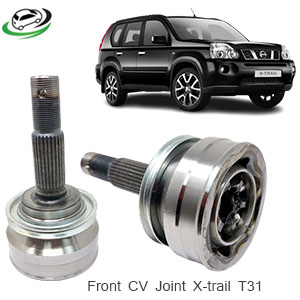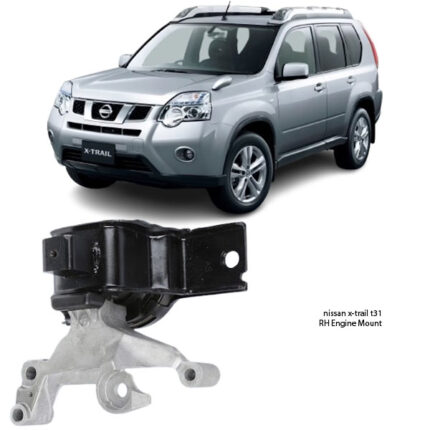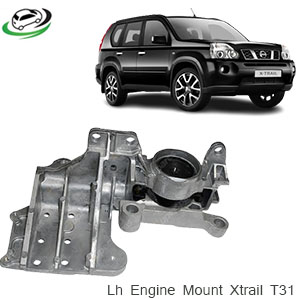-26%
Get Front LH Engine Mount 11220-JD200 Nissan X-Trail T31, Dualis J10
Engine mounts, also known as motor mounts, are crucial components of a vehicle’s engine support system. They serve multiple functions aimed at enhancing vehicle performance, comfort, and safety. Recognizing signs of worn engine mounts is essential for maintaining optimal vehicle operation and preventing potential damage. Let’s explore their functions and signs of wear:
Functions of Engine Mounts:
- Vibration Isolation: Engine mounts dampen vibrations and shocks produced by the engine during operation, preventing them from transmitting to the vehicle’s chassis and passenger compartment. This helps reduce noise, vibration, and harshness (NVH) levels, enhancing ride comfort for occupants.
- Engine Support and Stability: Engine mounts provide support and stability to the engine, securing it in place within the engine bay. They help maintain proper engine alignment, preventing excessive movement or shifting during acceleration, braking, and cornering.
- Absorption of Engine Torque: Engine mounts absorb and dissipate the torque generated by the engine, especially during rapid acceleration or sudden changes in engine speed. This prevents excessive engine movement and twisting forces, which can strain other components and affect vehicle drivability.
- Noise Reduction: Engine mounts help minimize engine noise and vibrations transmitted to the vehicle’s structure, reducing cabin noise levels and enhancing overall comfort for passengers. They act as a buffer between the engine and the chassis, isolating mechanical vibrations and resonances.
- Protection of Components: Engine mounts protect surrounding components, such as the exhaust system, cooling system, and drivetrain, from excessive movement and vibration-induced damage. They help maintain the integrity of these systems and prolong their lifespan.
Signs of Worn Engine Mounts:
- Excessive Engine Movement: A noticeable increase in engine movement or shifting, especially during acceleration, deceleration, or gear changes, indicates worn or damaged engine mounts. Excessive movement may cause the engine to tilt or rock excessively, affecting vehicle stability and drivability.
- Vibration and Noise: Worn engine mounts can lead to increased vibration and noise levels in the vehicle, particularly at idle or during acceleration. Vibrations may be felt through the steering wheel, floorboards, or seats, accompanied by rattling, shaking, or buzzing sounds.
- Visible Damage or Wear: Inspect the engine mounts visually for signs of damage, such as cracks, tears, or deterioration of the rubber or metal components. Damaged mounts may appear collapsed, distorted, or separated, indicating the need for replacement.
- Engine Misalignment: Misalignment of the engine relative to the chassis or drivetrain components can occur due to worn or sagging engine mounts. This may result in difficulty shifting gears, abnormal clutch engagement, or increased drivetrain noise.
- Excessive Engine Tilting: If the engine appears to tilt or sag to one side, it may indicate uneven wear or failure of one or more engine mounts. This can affect engine performance, vehicle balance, and clearance between engine components and the vehicle’s body or frame.
- Fluid Leaks: Some engine mounts contain fluid-filled chambers or hydraulic dampers to further reduce vibrations and noise. Leaks from these mounts may indicate internal damage or deterioration, compromising their effectiveness and requiring replacement.
- Increased Wear on Other Components: Worn engine mounts can cause increased wear and stress on surrounding components, such as the exhaust system, drivetrain mounts, and suspension components. Inspect these areas for signs of abnormal wear or damage, which may indicate underlying issues with the engine mounts.
Inspection and Replacement:
- Regular Inspection: Include engine mounts in routine vehicle inspections, checking for signs of wear, damage, or abnormal movement. Pay attention to symptoms such as vibration, noise, engine misalignment, and excessive movement.
- Timely Replacement: If any signs of worn or damaged engine mounts are detected, it’s essential to replace them promptly to prevent further damage and ensure safe vehicle operation. Follow the manufacturer’s recommendations for replacement intervals and use quality replacement mounts.
- Professional Service: Engine mount replacement may require specialized tools and expertise, especially if it involves supporting the engine and removing other components. It’s advisable to have a qualified mechanic or technician perform the replacement to ensure proper installation and alignment.
- Quality Parts: Use high-quality replacement engine mounts from reputable manufacturers to ensure compatibility, durability, and performance. OEM (Original Equipment Manufacturer) or aftermarket equivalents are available for most vehicles.
By understanding the functions of engine mounts and recognizing signs of wear, vehicle owners can take proactive measures to maintain optimal engine support and vehicle performance. Regular inspection, timely maintenance, and professional replacement when necessary are key to preserving the integrity and functionality of engine mounts in vehicles.



